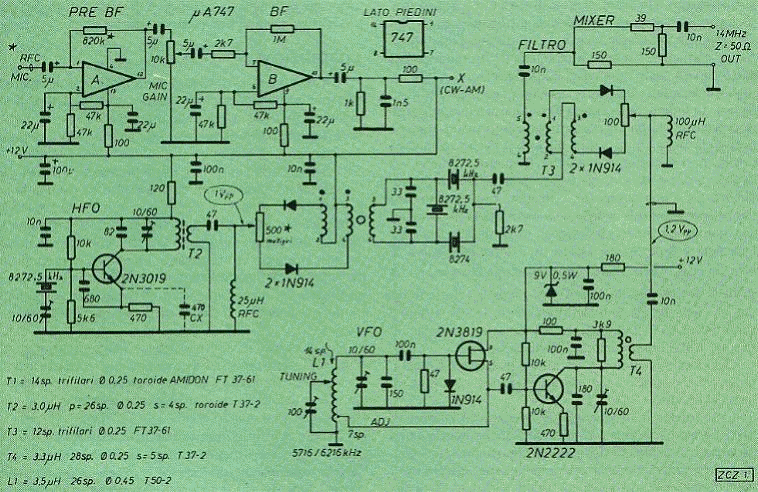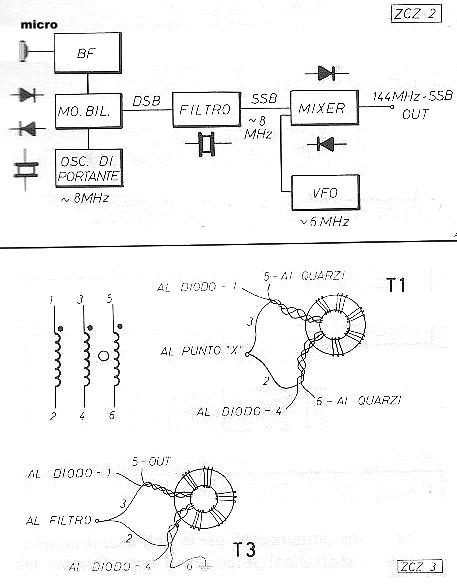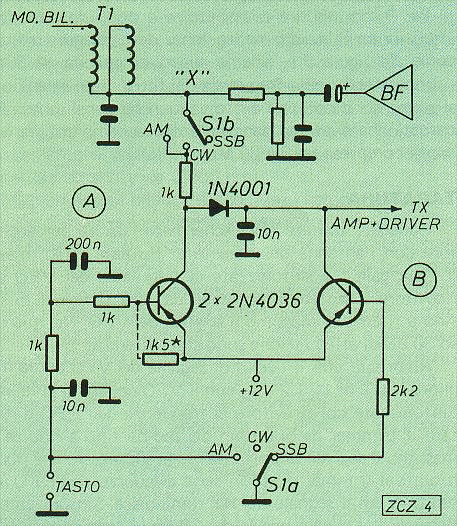

Caratteristiche: modo:USB,(cw e am compatibile)
Zout: 50ohm
Vpp> 30mV
Attenuaz.banda indesiderata: " 30db
Attenuaz.portante: " 44db
Frequenza :14-14.5mhz
Banda passante "2,4 khz(-6db)
Mixer : a diodi(larga banda)
Attenuazione vfo: " 36db
Note: l'intero circuito puo'essere modificato facilmente per altre bande e non ha bisogno di pesanti schermature grazie ai toroidi adoperati.Esso lavora per somma:Fxtal+Fvfo.
L'immagine "2,5mhz è lontana e facilmente filtrabile.
Pre bf ,bf
Accetta qualsiasi microfono,si consiglia una economica capsula piezo per una modulazione particolarmente brillante ed efficace per la ssb
Mod.bilanciato
Non è necessario usare costose o non facilmente reperibili coppie o quaterne selezionate di diodi.
Tuttavia fra i diodi in possesso sceglierne 2 che abbiano pressocchè la stessa resistenza diretta ed inversa,provvederà il trimmer alla rifinitura
Oscillatore di portante
fornisce un robusto segnale di 2vpp C da 47pf ne limita l'uscita = 1Vpp è ideale per la migliore resa dei diodi,con onda sinusoidale
Filtro a quarzi
3quarzi +1 HFO: i quarzi dovranno essere nominalmente uguali,uno andrà spostato di
1,5 khz piu' in alto.
VFO
molto stabile e semplice,Vout=1,2vpp connesso al circuito.
Taratura
Bf: inserite il microfono e il tester fra C : 5microF e massa.Lindice deve seguire la modulazione (Vca).Rfc= anello in ferrite per prevenire rientri rf sul microfono.togliere il tester ed inserire una cuffia con una resistenza in serie.Regolare l'audio per una modulazione perfetta e senza fruscii o rumori.fatto questo tariamo il mixer per la migliore soppressione del VFO,ruotando delicatamente il trimmer del mixer (meglio se multigiri) per ridurre il piu' possibile il segnale 36db nel mio caso_Sintonizziamo ora Rx sulla frequenza dell'HFO.ruotiamo il trimmer(meglio multigiri) per la migliore soppressione possibile del segnale,migliorando poi, con il trimmer in serie al quarzo dell'HFO.Sintonizzare infine l'Rx sui 14 mhz e centrare il segnale del nostro Tx..Sarà debole perché udremo il residuo di portante.Infilare una cuffia sul ricevitore per evitare l'effetto Larsen e ritoccare se necessario il trimmer soppressione portante all'uscita dell'HFO per il minimo.Portare da zero ad un terzo di corsa il guadagno microfono e provare con il magico"ooolà",udremo un segnale incomprensibile nel ricevitore mentre l'S-meter seguirà allegramente la modulazione:siamo in SSB .Provare ora a centrare bene il segnale e verificare la qualita' audio intervenendo sul mic gain.Se non è naturale ,ritoccare il compensatore in serie al quarzo dell'HFO senza tagliare troppo i bassi.(nel mio caso residuo portante S -1 massima modulazione S-9 ).Infine controlliamo la rejezione della banda indesiderata(LSB): sintonizziamo RX su LSB con battimento zero sul residuo di portante: mic = zero.
Regolare il mic gain sulla posizione ottimale prima trovata in USB e scandire "ooolà", annotando la massima lettura di S-meter.Questa sarà inferiore alla precedente(USB) di almeno 30db.Commutiamo RX su AM verificando l'incomprensibilità della modulazione.Note finali: CW =viene sbilanciato il mod.bil. per emettere portante.AM = il mod .bil. resta sbilanciato,variare il mic gain per una modulazione ottimale.La modulazione sarà un po' stretta per via del filtro,ma comprensibile,meglio sarebbe spostare la frequenza dell'HFO di alcune centinaia di Hertz.
Features:
mode:USB,cw-am compatible
Zout:50ohm
Vpp>30mV
Lsb band suppression: " 30db
Carrier suppr.: " 44db
Frequency :14-14.5mhz
passband: "2,4 khz(-6db)
Mixer:wide band
Vfo suppression: " 36db
Note: this design can be modified easely for other bands and it doesn't need heavy shielding(toroid coils).Fout = Fxtal + Fvfo,the image "2,5mhz is quite far and easy to filter out.
Pre-af ,af : any mic will be accepted, a cheap piezo-mic is the best one for a very effective speech quality Balanced modulator:Choose a couple of diodes with almost same charateristics by a multimeter .It doesn't needs special coupled diodes .Any difference will be nulled by the suppression trimmer.HFO: 2vpp and sinusoidal wave,1vpp on diodes,for the best driving signal.
Xtal filter: 3 + 1 HFO; all xtals have to be choosen with the same nominal frequency,one of them will be shifted 1,5khz higher.
VFO
Rock stable easy design(less components, less chances for drifting).Vout=1,2Vpp loaded
Tune up procedure
Af : plug in the mic and connect the multimeter
Vac between 5 mF capacitor and ground. The needle (analogic tester) will follow our modulation.Connect an earphone through a resistor to the audio out,adjust mic gain for the best modulation,without noise and distorsion.Insert a little ferrite ring on the audio input to void RF feedback
HFO : use the RX to test the HFO,adjusting for the best signal. Next,it will be useful for testing the xtal filter
Xtal filter: FT243 xtals are the best choice,they can be opened by screws.Test all the xtals taking note of the frequencies (Rx will help).Little differences will be tolerated,choose three of them and the fourth one will be shifted 1,5 khz higher.Tin wire will help to lower the frequency.Cleaning powder(eg.Ajax) will rise it.Soft and delicate movements are requested .Avoid the corners.Rinse the xtal and rinse out a second time using alcohol.
Final notes :
Connect the exciter output to the Rx input and set the mic-gain on zero.Tune the Rx on the VFO frequency and adiust the vfo controls to get the frequency spanning desired.Now,adjust the mixer trimmer for the best vfo signal suppression (36db on my exciter).Tune up the rx on the HFO frequency and adjust the carrier suppression trimmer for the best suppression available.The capacitive trimmer on the HFO xtal will help to reach our goal.Now,our Rx will be tuned on 14 mhz : search for the exciter output signal: it will be weak (residual carrier) Plug in an earphone to void audio feed-back. Turn the mic-gain to one third ,and speaking into the mic our signal will be heard on the rx but it will be incomprehensible and the needle of the s-meter will follow our modulation peaks.The tx signal have to be tuned correctly,the speech quality have to be good and natural.The signal will range from S 1 to S 9.If modulation doesn't sound good try to adjust the HFO trimmer.A short control of the undesired band (LSB): shift the rx control on Lsb and tune the rx on zero-beat. Speaking again our signal will be much lower than before(at least 30 db).Of course,selecting the AM mode on the rx our modulation will be incomprehensible.
CW :The balanced modulator will be unbalanced and the carrier will be present.
AM :Again the bal.mod.will be unbalanced,adjust the audio signal for the best speech quality.The signal will be quite narrow due to the filter action and a little shift of the HFO frequency have to be expected.

